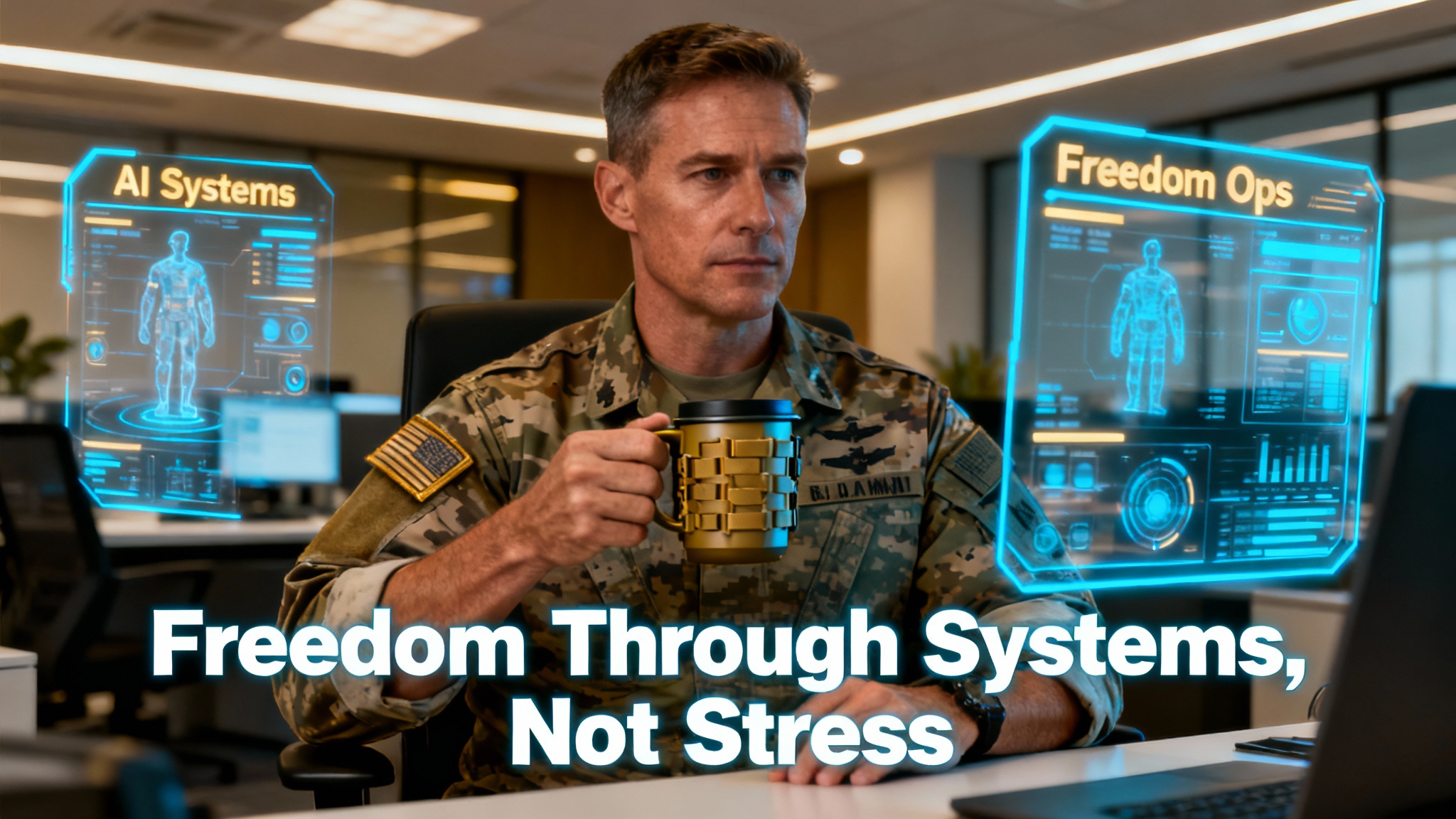Let me take you back: It’s 0200 in the middle of a blacked-out FOB, the generator is sputtering, and the radio is crackling with new orders. That rush, that focus? It’s oddly familiar when your first civilian water bill pings your inbox at midnight—except this time, the chaos feels bigger and the stakes, in a way, more personal. Turns out, structure isn’t just for field ops—it's the missing armor in the battle for civilian freedom. However, the common misconception is that freedom doesn't come from working harder, but rather from working smarter, with systems (and a few AI assistants) monitoring your actions.
1. From SOPs to Sales Funnels: Why Chaos Needs Structure
In the military, chaos is a given—but it’s never left to chance. We had SOPs (Standard Operating Procedures), checklists, and routines for everything. That structure wasn’t just for show; it was the backbone that kept missions on track, even when the unexpected hit. When I transitioned to civilian life and started building my own business, I realized something fast: the same discipline that kept me alive in uniform could anchor my success as an entrepreneur—especially when paired with AI automation systems.
Too many veterans enter the business world with the belief that hard work will suffice. But here’s the painful truth: stress doesn’t pay the bills—systems do. The veterans thriving in civilian life aren’t the ones grinding 16-hour days. They’re the ones who’ve built automation workflows for small businesses that run while they sleep. That’s the real secret to stability and growth.
Let’s draw a line from the field to the digital world. In the military, you’d never launch a mission without a plan. So why run a business without a system? Building business systems for veterans means turning chaos into predictability. The Value Ladder concept in business serves as a transformative tool. I learned from Russell Brunson. Russell Brunson teaches that you should map out every step your customer takes, from first contact to final sale, like a mission plan. Each offer, each message, and each funnel is a rung on the ladder, guiding people upward in value and trust.
“If you build your business like you planned a mission, you’ll stop reacting and start commanding.” – Russell Brunson (paraphrased)
AI is the force multiplier here. Just like a well-drilled team, AI automation systems can handle repetitive tasks—capturing leads, sending follow-ups, analyzing data—so you can focus on strategy and growth. It’s not about working harder; it’s about letting systems do the heavy lifting. The same way SOPs brought order to chaos in the field, sales funnels and automation bring stability to your income. That’s how veterans are winning: by turning their trademark grit into repeatable, scalable results.
2. Is Freedom Just a Better-Lit Sort of Stress? Ditching the Hustle for Automation
When I left the military, I craved freedom—no more 5 a.m. wake-ups, no more rigid schedules. But I quickly learned what many veterans do: freedom without structure is just stress with better lighting. As Jonathan Montoya says, “Freedom without structure is just stress with better lighting.” I found myself hustling, chasing clients, and putting out fires all day. I wasn’t free. I was just self-employed and stressed.
Here’s the hard truth: Most veterans leave service dreaming of freedom but fall into the trap of unguided, stressful self-employment. We toss aside the discipline we learned in uniform—following SOPs, executing missions, relying on repeatable systems. We forget that freedom through structured systems is what truly delivers peace of mind.
From Self-Employed to System-Employed
What changed everything for me was learning to build repeatable systems in business. Instead of hustling for every sale, I set up automated content, lead capture, and follow-up using AI tools. Suddenly, my business continued to operate even when I was not actively working. I moved from being self-employed to system-employed—and that’s where real freedom lives.
Automated content: AI writes, schedules, and posts while I spend time with my family.
Lead systems: Funnels capture and nurture leads 24/7, not just when I’m online.
Marketing automation for veterans: Email sequences and chatbots convert attention into income, freeing my mind from constant worry.
Jonathan Montoya’s Freedom Accelerator: Mission Planning for Business
Jonathan Montoya’s Freedom Accelerator program drove this home for me. He teaches veterans to stack workflows, automations, and funnels just like prepping for a mission. You build the system once, and it runs continuously—capturing leads, converting income, and giving you back your time. As Montoya says, the path to quitting your 9-to-5 is through systems that compound effort, not increase it.
The benefits go far beyond money. With structured business systems and automation workflows, my mental health improved, I had more time for my family, and I finally felt clarity and control. Discipline from military life is the secret weapon here—because anyone can download an app, but only veterans have the grit to run it like a mission.
3. AI as Your New Battle Buddy: Reassigning, Not Replacing, the Mission
Let’s get one thing straight: AI isn’t here to take away opportunity for veterans—it’s here to reassign the mission. When I first heard about AI tools for veteran entrepreneurs, I’ll admit, I was skeptical. But the more I dug in, the more I realized: AI automation systems for veterans aren’t about replacing us. They’re about automating the digital grunt work so we can focus on higher-value tasks—just like delegating routine checks to a reliable squad member.
Look at what’s happening at the Department of Veterans Affairs (VA). They’ve rolled out AI-powered digital assistants and Robotic Process Automation platforms to handle claims processing. What used to take weeks now takes hours, and the accuracy is up. That’s not just tech hype—it’s real, boots-on-the-ground improvement in veteran service delivery.
“AI doesn’t replace the veteran who learns it. It replaces the civilian who ignores it.”
I’ve seen such improvements play out firsthand with OfferLab Certification grads. These aren’t folks chasing the latest trend—they’re building sustainable businesses by deploying AI for content creation, lead capture, and sales automation. They use low-code and no-code RPA tools to automate everything from scheduling to analytics, freeing up time to focus on strategy and growth. That’s recurring revenue, not just one-off wins.
AI and job reassignment for veterans means you’re not stuck doing repetitive digital paperwork—you’re leading, innovating, and scaling.
With AI automation systems for veterans, you can build content funnels and sales workflows that work 24/7—no more hustling for every single lead.
Platforms like OpenAI are even expanding data centers in veteran-heavy areas, creating new economic opportunities and partnerships for veteran-owned businesses.
If you’ve got the discipline to learn new tech—just like you learned new gear—you’ll outpace those ignoring the shift. Here’s my practical tip: see AI not as a threat, but as your newest squad member—one that never sleeps, never forgets a checklist, and always has your six.
In this new era, the real winners are the veterans who embrace AI as a battle buddy, not a rival. The mission hasn’t disappeared—it’s just been reassigned. And with the right systems, you’re still leading from the front.
4. The Hidden Weapon: Discipline as the Driver of Digital Success
If there’s one thing I took from my military days into my journey as an entrepreneur, it’s this: Discipline is the real secret weapon. When it comes to building business systems for veterans, flashy automation tools and AI apps get all the attention. But the truth is, anyone can download an automation app. Only veterans have the discipline to run it like a mission.
In the service, we lived by routine—morning checks, gear inspections, and after-action reviews. That same discipline is what powers automation workflows for small businesses. It's not just about establishing a system once and hoping for success. It’s about relentless weekly reviews, course corrections, and steady improvement—just like mission debriefs. This is where many civilian entrepreneurs fail. They get excited about passive income generation, but when the system needs tweaking, they lose focus. Veterans, on the other hand, thrive on structure and feedback.
Here’s what I’ve learned: Discipline in veteran entrepreneurship isn’t just about working hard. It’s about working smart, consistently. Every Monday, I review my metrics—open rates, conversion stats, lead flow—just like I used to review mission outcomes. If something’s off, I adjust. If a workflow breaks, I fix it. This routine turns “systems overwhelm” into steady progress. Over time, those small, disciplined actions compound into real, reliable results.
Let’s be honest: downloading an automation app is easy. Running a system like a mission takes true grit. That’s the edge we bring to the table. We don’t just set and forget; we monitor, adapt, and improve. That’s how passive income generation for veterans becomes a reality—not through luck, but through discipline and routine.
'Anyone can download an automation app. But only veterans have the discipline to run it like a mission.'
Every workflow, funnel, and automation I build is designed to free up time for what matters—my family, my peace, and my purpose. But none of it works without the discipline to keep the system running, to review and refine, week after week. That’s the hidden weapon. In a world obsessed with shortcuts, it’s veteran discipline that drives digital success and keeps the mission moving forward.
5. Wild Cards: Lost Orders, LEGO Kits, and a Freedom Checklist
Let me tell you about the time I lost my field orders in the middle of a training op. One minute, I was squared away; the next, I was patching together a “mission brief” with duct tape, a Sharpie, and a wobbly morale patch. My squad held me responsible for weeks. In retrospect, it was humorous, yet it underscored a crucial lesson: the absence of a system leads to improvisation, which is not always beneficial. In business, that kind of chaos costs you leads, sales, and occasionally your sanity.
That’s why building repeatable systems in business is non-negotiable, especially for veterans stepping into civilian life. Consider it similar to assembling a LEGO kit. At first, you follow the manual—piece by piece, step by step. That’s your automation workflow: lead capture, content funnel, and follow-up. Once you’ve mastered the basics, you can remix, experiment, and build something uniquely yours. But skip the instructions, and you’ll spend more time searching for missing bricks than building anything that lasts.
AI automation systems for veterans aren’t about replacing grit—they’re about channeling it. When you set up effective lead capture strategies and automation workflows for your small business, you’re not just working harder; you’re working smarter. The real win? You get to step back, let the system run, and finally enjoy the freedom you fought for. Maybe that means teaching your kid chess, taking a quiet walk, or just having coffee without your phone buzzing every five minutes.
Here’s my freedom checklist, battle-tested and simple: Plan your mission, build your system, deploy AI, measure results, and iterate relentlessly. Systems improve through feedback, not perfection. The beauty is, once your automation is humming, you’re free to focus on what matters most—because your business keeps moving even when you’re not watching every move.
Remember: stress is a signal you’re missing a system.
So if you find yourself duct-taping your business together, take a breath. You already have the discipline and grit. Now, build the framework. Let AI and automation handle the chaos so you can finally enjoy the freedom you earned—no duct tape required.



